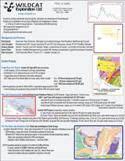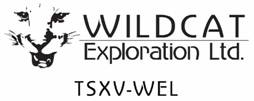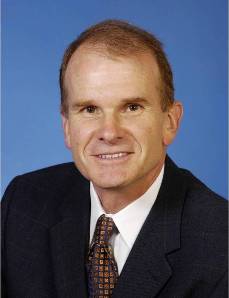|
Resources
|
CEOCFO-Members Login
Become A Member!
Wildcat Exploration Ltd.
(WEL-TSXV)
Fact Sheet

|
This is a printer friendly page!
Wildcat Exploration is Focused On Exploring
And Discovering
Precious and Base Metals In Manitoba And
Saskatchewan, Canada
- Two Of The Top Jurisdictions For Mining In The World

Mining
Gold and Base Metals
(WEL-TSXV)
Wildcat Exploration Ltd.
Suite 203,
1780 Wellington Avenue
Winnipeg MB Canada R3H 1B3
Phone: 204-944-8916

John L. Knowles
President and CEO
Interview conducted by:
Lynn Fosse, Senior Editor
CEOCFOinterviews.com
Published – September 5, 2008
BIO:
Mr. Knowles is a chartered accountant with more than 20 years of resource
industry experience in Canada and internationally. He is the former
Executive Vice President and CFO of Aur Resources Inc., prior to which he
was Vice President and CFO of HudBay Minerals Inc. and its wholly owned
subsidiary, Hudson Bay Mining and Smelting Co., Limited. Mr. Knowles is also
Chairman of Dourave Mining and Exploration Inc., a Canadian company
exploring for gold in Brazil, and a director of Prairie Plant Systems Inc.,
a Canadian biopharmaceutical company.
Company Profile:
Wildcat Exploration
Ltd. is a TSX Venture - listed Winnipeg-based company exploring for gold and
base metals in Canada. Its portfolio includes: (1) the Foster River
zinc-lead project in Saskatchewan, (2) three gold properties and one gold
and platinum group element (PGE) property in the Rice Lake greenstone belt
in Manitoba, and (3) two PGE and base metals properties in the Snow Lake
area of Manitoba. As the Company builds its property portfolio, Wildcat
welcomes proposals from owners of advanced Canadian exploration properties.
CEOCFO: Mr.
Knowles, what’s the vision at Wildcat?
Mr. Knowles:
“Wildcat is a publicly-listed mineral exploration company and we have
projects in the central provinces of Canada in Manitoba and Saskatchewan.
Our vision is to generate shareholder value by discovering and building
resources and reserves of precious and base metals, because we have both of
those in our projects.”
CEOCFO:
Tell me a little bit about your main projects.
Mr. Knowles:
“We are in three prime mining and exploration areas of Manitoba and
Saskatchewan, with 9 different properties. Those two provinces, according to
the global survey by the Fraser Institute, which is a well-known
organization in British Columbia, are ranked two of the world’s top
jurisdictions for combined geological attractiveness and friendliness to
mining. These are great provinces for exploration. In fact, the project
areas that we are in are very active, with several recent discoveries or
additions to reserves by companies that are neighboring us. We are very
pleased with our project locations.”
CEOCFO:
What do you like about the areas that you are in?
Mr. Knowles:
“We are in the Rice Lake greenstone belt, in southern Manitoba, an
historical gold mining camp dating back 90 years, which lay idle during the
last surge in mining in the seventies. However the area has seen well over
$100 million dollars of development and exploration in the past decade or
so. Gold production to date has totaled over 1.6 million ounces and recent
discoveries bode very well for a lot more to come. We have built an
extensive portfolio of gold properties in the belt, including two historical
small but high-grade gold mines, and we are focusing on employing modern
exploration technology to extend these historical deposits and find new
ones. We have already achieved results at the Jeep Project, historically the
richest grade producing gold mine in this area of the gold belt, achieving
concentrations up to 109.5 grams per tonne over 0.78 meters. (over 3 ounces
per ton). Secondly, in northern Manitoba we are in the Flin Flon-Snow Lake
greenstone belt, for 80 years, an area that’s produced a lot of copper and
zinc. One company, Hudson Bay Mining and Smelting, with which I am very
familiar, owned most of the area for that whole period. With the ground tied
up, there wasn’t a lot of activity, other than the work they decided to do.
They have discovered and operated about 30 separate mines in the area over
that period. However, they have recently changed their course and have
started optioning their properties out to junior companies to explore. As a
result, activity has increased markedly. Our properties in the Flin Flon-Snow
Lake Belt are surrounded by discoveries that have been announced within the
last 12 months. It’s a very hot area.
In the Rice Lake and Flin Flon-Snow Lake areas,
both of which are historic mining camps, we are doing what a lot of industry
people say is a good rule of thumb and that is, explore in the shadow of the
head frame of another mine. In other words, the best place to find new mines
is close to old mines. We are in camps where there is a history of
production current and a lot of activity.
The third area for us is in Saskatchewan, a
project we call Foster River. It has the potential to be a company maker all
on its own. It is a large land holding of about 12,000 hectares (about
29,000 acres), and the mineralization that we found there is very similar to
a huge well-known zinc-lead and silver mine in Australia called Broken Hill.
That deposit was so large that other similar types of mineralized deposits
are given the term Broken Hill type by geologists and the term is used
globally. There are now several known deposits around the world, in
Scandinavia, South Africa and Australia, which are called Broken Hill type
deposits. And we are in a great position right now. Our work to date on the
project is now gaining traction with industry experts in the field and they
are in agreement with us in that we are now proving the first Broken Hill
type mineralized occurrence on the North American continent. Historical
drill results tested and found zinc concentrations in a couple locations on
thee property. We are now starting to link those areas together, in some
cases a distance of 5 kilometers, by identifying the surface features, the
stratigraphy, that are associated with the mineralization. Our geochemical
program indicates that we may also have concentrations of silver and lead on
the property, which makes the project all the more similar to other Broken
Hill type deposits which contain a combination of zinc, lead and silver.
We’re increasingly excited with each new piece of information that our
geological team brings in.”
CEOCFO: Do
you own your projects 100%?
Mr. Knowles:
“We own almost all of our projects 100%. We have optioned out one property
in the Rice Lake area to another company who can earn up to 100% by spending
$5 million on it and giving us close to $1 million over 5 years. We have the
right to retain a 35% interest in that property which is called Poundmaker.
Therefore, we may end up with 35% interest or if they go all the way in
their spending and we don’t elect to keep it, we will end up with a royalty
interest on that property. In another transaction, we optioned into two
extra claims tagged onto our wholly owned Jeep property, and we will own 25%
of those two claims. Other than that, all of our projects are 100% owned.”
CEOCFO: Did
you find it difficult to get people and equipment in the current
environment?
Mr. Knowles:
“It has been challenging in the last twelve months. The global mining
industry has been extremely active in a positive way. That means, there have
been lots of opportunities for geologists, drilling companies and assay labs
to have lots of work. It makes it more difficult for companies of every size
to find good people. We however have been fortunate in that regard. We have
had no difficulty attracting a very talented team of young geologists and
they are led by Peter Theyer, Ph.D., who has 30 years experience, much of it
in the areas where we are focused. We have a great mix of people working on
our projects.”
CEOCFO:
Tell us the financial picture of the company today.
Mr. Knowles:
“In June we completed a financing and raised $1.4 million. The initial size
was smaller, but we became oversubscribed, which speaks to the positive
opinion of the marketplace of our projects and our people. The exploration
programs that we plan for this year are fully funded. We continually assess
our activities, and the market, with the new findings that our geological
teams are discovering. Of course, as a junior exploration company, our
shareholders expect us to spend money. Until a junior exploration company
has a very successful property, it is usually not bringing in revenues. We
rely on investors who wish to devote some risk capital to our enterprise.
The rewards can be substantial. When and for which project we are going to
raise money next is decided by results from the latest activity in each
program, and our finances are pretty strong right now for the coming year.”
CEOCFO:
What is it that Wildcat knows that allows you to be successful and sets you
apart from some of the others?
Mr. Knowles:
“In the areas that we are working in, our technical people have key
expertise. Our geological team is led by Peter Theyer, who is a recognized
expert in platinum and palladium, what they call platinum group element (PGE)
metals, as well as gold and base metals based on his years working for the
Government of Manitoba Geological Survey. Prior to that, he worked for
Falconbridge, which is a big base metal mining company now part of Xstrata
plc. Supporting our in-house expertise we are very happy to have what we
call our technical advisory panel. This is a group of four individuals, who
are eminent explorationists, each with specific industry expertise and with
many years of experience. One has run exploration programs for large
publicly owned companies. Another is an international expert in geochemical
surveying. A third one is a consultant with one of Canada’s foremost
geological consulting firms.
The fourth, Paul Spry, is a Professor at Iowa
State University. Paul is a world-renowned expert in Broken Hill type zinc
deposits. He is quite interested in our property, the Foster River Project,
and did not hesitate to accept Wildcat’s invitation to join our advisory
panel. In fact we’ve broadened the relationship between ourselves and Paul
and Iowa State University, where our project is the subject of ongoing
graduate thesis work. We have access to a real brain trust in our technical
advisory panel as well as our talented in-house people.”
CEOCFO:
Wildcat is looking for advanced projects; would you tell us about your
strategy?
Mr. Knowles:
“As I mentioned, we have nine properties already, at various stages of
exploration. The goal of every exploration company is to build up resources
and reserves of the target metals on each property, which are technical
terms used in the industry. In reserves one has more confidence than
resources. We, at this point don’t have resources or reserves that we can
point to although we’ve got projects that have lots of potential for that.
However we don’t stop there. We are continually evaluating other projects
including those that are advanced enough that they indeed have resources or
reserves on them, or where there has been enough work done that we see a
realistic probability of having those defined in a relatively short period
of time, which might be one to three years. Translating for lay people like
you and me (I’m an accountant by training), resources and reserves refer to
key characteristics of a deposit that you can outline in three dimensions;
you can say, “Okay, it’s this long, this wide and this deep and it has such
and such a grade. Therefore, I can now estimate how much metal is in it and
how much it will cost to mine and how much profit there could be”. Until you
have that, you really don’t know what the value of your property could be.
We are not at that stage yet but it is our intent to get to that stage as
quickly as we can. That’s our strategy.”
CEOCFO:
Sum it up for potential investors; why pick Wildcat out of the crowd?
Mr.
Knowles:
“Wildcat’s current stock price is very attractive relative to other
companies that have fewer good projects, and do not have a team as qualified
as ours. We have a diversified portfolio in precious metals and base metals,
and are advancing all of our projects. We’ve got exploration work planned in
2008 for several projects in all three of the camps that we are working in,
and the team is poised to be proactive in 2009 planning as the results roll
in. We operate in politically stable and friendly jurisdictions, where there
is a mining culture spanning a century, experienced people available
locally, and elephant sized deposits in the area. We have a strong technical
team, an eminent advisory panel, a management that is committed, and an
experienced and savvy group of directors. I think Wildcat offers a
very
attractive situation right now, to investors who want join with a talented
group looking for growth in this market.”
disclaimers
Any reproduction or further distribution of this
article without the express written consent of CEOCFOinterviews.com is prohibited.
|


